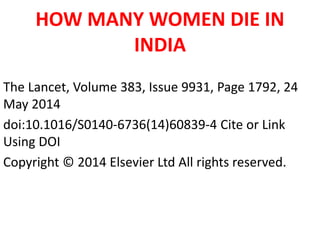
How many women die in india
- 1. HOW MANY WOMEN DIE IN INDIA The Lancet, Volume 383, Issue 9931, Page 1792, 24 May 2014 doi:10.1016/S0140-6736(14)60839-4 Cite or Link Using DOI Copyright © 2014 Elsevier Ltd All rights reserved.
- 2. How many women die during pregnancy and childbirth in India? If you believe the estimate from the United Nations, the number is 50 000.
- 3. • But if you believe the Institute for Health Metrics and Evaluation (IHME), the figure balloons to 71 792. Both numbers are vast, of course. India has the unfortunate distinction of being the country with the highest number of maternal deaths, whichever way you calculate the figure.
- 4. • But if you were India's new Prime-Minister- elect, Narendra Modi, you might just alter the urgency with which you acted to reduce maternal mortality if you believed the UN figure, which records a remarkable 21 792 fewer maternal deaths than the independently calculated estimate from a competing large international collaboration. It would not be unreasonable if other Presidents and Prime Ministers, let alone Ministers of Health, were confused by these often strikingly divergent results.
- 5. • 75 countries are officially monitored by the independent Expert Review Group on Information and Accountability for Women's and Children's Health (iERG). This small group (Joy Phumaphi and I are co-chairs) was created in 2011 to monitor, among other measures, progress towards Millennium Development Goals 4 (on child mortality) and 5 (on maternal and reproductive health).
- 6. • Our 75 countries of concern represent 97—98% of all global maternal deaths. 15 of these countries must now weigh up the meaning of differences of over 1000 maternal deaths between the two best sources of data they can turn to. The table below lists these 15 countries
- 7. • Each figure uses the UN number as a baseline and indicates the IHME difference, plus or minus, compared with that UN estimate. So, 10 875 for the Democratic Republic of Congo means that IHME calculates maternal deaths to be 10 875 fewer than the official UN figure. These differences are not at all obvious when one examines the headline numbers from each source. IHME's global estimate for maternal deaths is 292 982. The equivalent UN figure is 289 000. But at the regional level, big differences begin to appear. Of the iERG's 75 countries, 42 are in sub-Saharan Africa.
- 8. • IHME puts total maternal deaths in these 42 countries at 141 252, the UN at 169 976. This difference of 28 724 maternal deaths is not a small rounding error. For southeast Asia, IHME estimates 94 275 maternal deaths, the UN 67 310—this time, 26 965 fewer. For the Eastern Mediterranean region of WHO, the UN estimates 11 084 fewer deaths than IHME (25 205 vs 36 289). For regional health leaders, such as WHO's Regional Directors, these large differences must be perplexing. Just what are they supposed to advise their member states when faced with such discrepancies?
- 9. • Ever since IHME began publishing child and maternal mortality estimates, differences between the two groups were smoothed over by arguing that trends mattered more than individual numbers. For small differences, perhaps this explanation is fair. But when differences are large, the credibility of both estimates risks being challenged. There is one opportunity to understand, if not fully resolve, these differences. Peter Piot, Director of the London School of Hygiene & Tropical Medicine, chairs a Gates Foundation funded Independent Advisory Committee for the Global Burden of Disease. That committee meets next month in Seattle.
- 10. • One of its remits is to “engage in dialogue with other efforts on global health estimates”. A further goal is to review strengths and weaknesses of the GBD's methods. But this second objective will solve only half of the problem. Someone also needs to assess the strengths and weaknesses of the UN's methods. Peter Piot's committee could consider conducting a careful comparison of methods used by both the UN and IHME.
- 11. • When Modi asks how many Indian women die during pregnancy and childbirth, he deserves a better answer than a number that varies by over 20 000 deaths. One also hopes that Modi's likely confusion will motivate his new Government to invest in India's neglected systems of civil registration and vital statistics.
